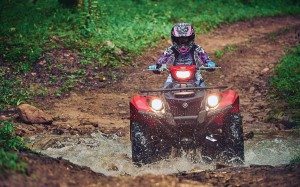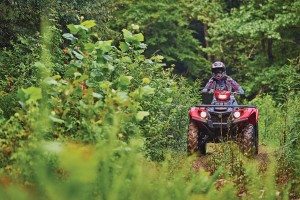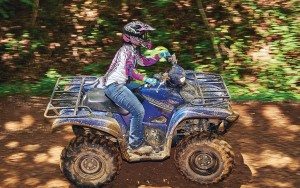One power plant, two different ATVs
Yamaha develops its 2016 Grizzly for play, while the Kodiak’s designed for work
When Yamaha set out to create its 2016 Grizzly 4X4 and Kodiak 700 4X4 models, the OEM wanted to bring two distinct models to market.
The Grizzly, with its new styling and chassis, On-Command 4WD system, 26-inch tires, two-piston four-wheel disc brakes and new suspension, was manufactured for recreational ATV riders. The Kodiak, however, with hydraulic disc brakes in the front and sealed wet brakes in the back, a mechanical rider-engaged 2WD/4WD system and 25-inch wheels, was developed as a work model, aimed square at farmers, ranchers and others who use ATVs — or who have employees who ride ATVs — to get work done.

As a point of distinction between the Yamaha ATVs and others in the work and play segment and the $6,999 and $8,899 starting price range, Yamaha has powered the Grizzly and Kodiak with 708cc power plants.
Yamaha introduced both models to media at a late July event at Windrock Park near Knoxville, Tenn., and though there was a clear distinction between the work-focused Kodiak and the aggressive and playful Grizzly, both were more than capable of taking on some aggressive hill climbing, creek crossings and rut maneuvering.
After a full day of climbing up and down the trails, I caught up with Travis Hollins, product planning manager at Yamaha, who explained the reasoning between the Grizzly and Kodiak differentiation.
“We basically just kind of saw the need for it,” he said. “In the past we had Grizzly; we had Grizzly 450, and we had a Bruin 350 before that. When we were out talking primarily just to people that are using them for more work related activities, the Grizzly was just a little too aggressive. It’s a big machine; it’s a tall machine; it’s got a lot of power. And the 450s and those sort of products in certain applications just didn’t have enough power. They thought the size was good, and the physical dimensions were good, but not the overall power.”
With those findings in mind, Yamaha matched a 708cc motor with a number of features that make the Grizzly a uniquely fun machine and the Kodiak a workhorse.
“When we were looking at the next generation and what we wanted to do, we kind of felt like if we had a vehicle and a power plant that we could tailor a little closer, we could take the Grizzly and push it a little more recreation; we can add a little more sportiness to that one, and then we could bring the Kodiak in and address the work guy a little more closely,” Hollins said.
As I jumped from the Kodiak to the Grizzly, the first characteristic that stuck out as different was the seating. The new large and plush Grizzly seat is built so the rider can have a more aggressive stance to help him or her tackle trails of varying difficulties. The Kodiak’s seat, however, is long and plush, designed for workers to spend time on the saddle, while also offering easy on and off for those who mount and dismount frequently throughout their day. What’s neat, though, is that the seats are easily replaced, so a rider could buy the Grizzly but purchase a Kodiak-style seat separately and switch between the two with ease, or vice versa with the Kodiak and a Grizzly-style seat.
A number of other features also show how Yamaha product developers worked tirelessly to make each model fit its unique niche.

“Something as simple as the brakes — when they’re developing the brakes, and they’re setting them up for the type of usage that they want, getting that power and getting that strength and getting all that they need for the recreational rider, that doesn’t necessarily translate to a work vehicle or the durability perspective that those guys are looking for, so it’s kind of a compromise. And we wanted to try to build machines that were a little more specialized and a little bit less of a compromise for everybody,” Hollins explained.
I spent most of my day traversing Windrock Park on a Kodiak, and among the features that made riding all day easy was the Ultramatic automatic transmission, which took away the worry over shifting while tackling obstacles. Hollins said that the Ultramatic — combined with the 708cc engine — should be appealing to farmers and ranchers and others who rely on staff that might be inexperienced with off-road vehicles to use them for work.
“If you ride a 450 or if you ride a 420 or any of those models, they tend to be busy feeling. The engines are higher RPMs. If you have to go from one place, to the next and it’s a fairly long distance, they tend to be revving a lot,” Hollins said. “What we found, particularly on some of the bigger farms where they’re using a lot of manual transmission models, a lot of the people using them weren’t necessarily enthusiasts. They didn’t know how to use the product, so they might leave them in first or second gear, and they just run them wide open, and they’re just revving to the moon, and so the Ultramatic automatic transmission eliminates all of that, makes it easy for them to ride.”
When Yamaha introduced the 2016 Grizzly and Kodiak to dealers this summer, Hollins admits there was some skepticism, especially as dealers were concerned that their customers might not want the power of a 700 in their ATVs. However, early sales exceeded Yamaha’s expectations, and models turned immediately. Hollins reported that one dealer who was nervous about taking on the 708cc models soon changed his tune as the units started leaving his showroom floor.
“One of the dealers basically called his district manager and said, ‘I wasn’t quite sure if this was going to be acceptable or not, but I need more. I’ve already sold the ones I’ve got; I need more.’ So it’s good to hear that they’re getting that feedback,” he told me.

During my ride, I found the Grizzly’s stance lent itself to some fun that the Kodiak didn’t bring. It whipped up dirt around corners playfully and tackled the trail with ease. But I also fund the Kodiak was more than capable of taking on some of the same hurdles, scaling the mountains and taking on steep declines and deep ruts without hesitation.
When I told Hollins how impressed I was with the capabilities of the “work” machine, he explained that though the Kodiak has a lot of work-focused features, it’s still a Yamaha ATV that’s ready to handle a little after-work fun as well.
“That’s what an ATV’s all about,” he said. “You can use it in all different scenarios and all different seasons, and they’re very capable.”
The MSRP for the Grizzly starts at $8,899 for non-EPS models and $9,699 with EPS. The SE Grizzly is $10,299, and the LE model is $10,899. The Kodiak 700 starts at $6,999, while the EPS model is $8,199, and the SE version is $8,899.








